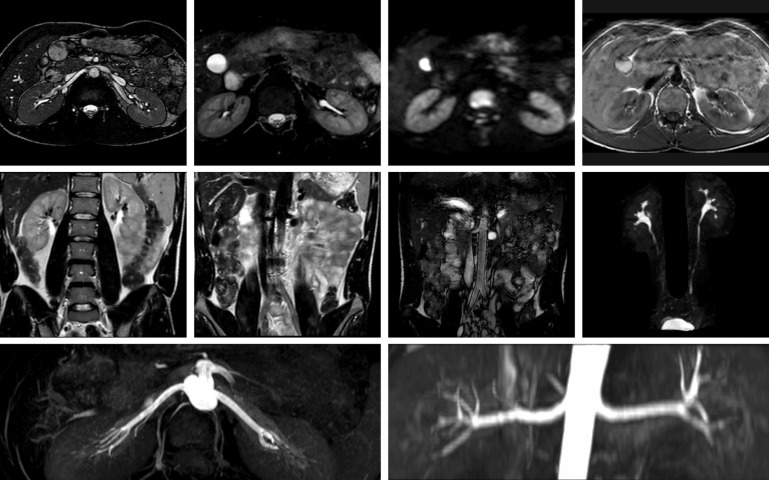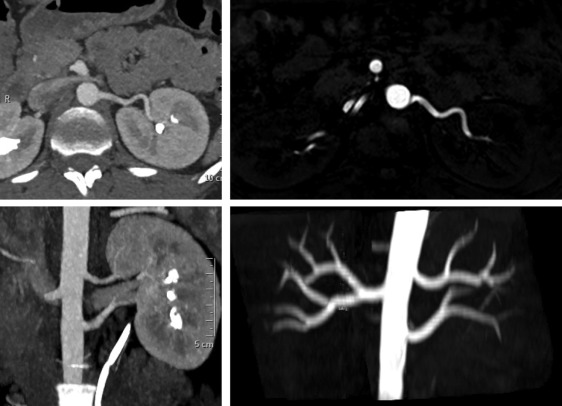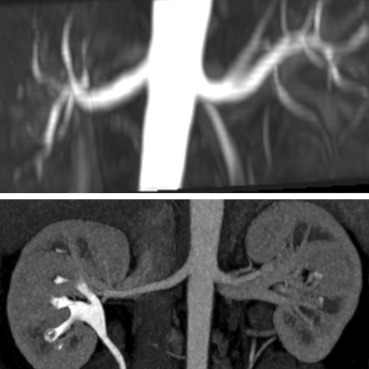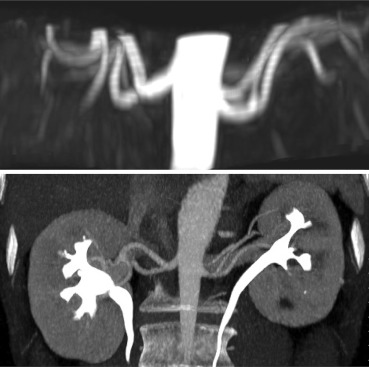Rationale and Objectives
Living renal donors undergo an extensive examination program. These examinations should be as safe, gentle, and patient friendly as possible. To compare computed tomography angiography (CTA) and an extensive magnetic resonance imaging (MRI) protocol without contrast agents to observations from nephrectomy in living renal donors and to evaluate whether noncontrast-enhanced MRI can replace CTA for vessel assessment in living renal donors.
Material and Methods
CTA and MRI results were compared to observations from nephrectomy, which served as the reference standard. Fifty-one potential kidney donors underwent imaging, and 31 donated a kidney. Comparisons in sensitivity, specificity, and accuracy were made with respect to the number of arteries, early branching, and the number of veins. Agreement was assessed using Cohen’s kappa. The exact McNemar’s test was used to test for statistically significant differences.
Results
In the assessment of more than one renal artery, the sensitivity and specificity of MRI and CTA were high and in perfect agreement compared to observations from surgery. The results for both MRI and CTA were as follows: (sensitivity 100%/specificity100%/accuracy 100%/Kappa = 1/ P = 1). When comparing the ability to test for early branching we found, MRI: (sensitivity 33%/specificity 100%/accuracy 87%/Kappa = 0.45/ P = 1) and CTA: (sensitivity 50%/specificity 100%/accuracy 90%/Kappa = 0.62/ P = 1). When used to depict supernumerary veins, we found MRI: (sensitivity60%/specifivity100%/accuracy 93%/Kappa = 0.72/ P = 1), whereas CTA showed: (sensitivity 40%/specificity 96%/accuracy 87% Kappa = 0.43/ P = 1).
Conclusions
In conclusion, an optimized MRI protocol that includes noncontrast-enhanced magnetic resonance angiography can be substituted for CTA for preoperative assessment of the renal vessels before living donor nephrectomy.
Renal transplantation is considered the treatment of choice for end-stage renal disease. Because of a lack of organs, an increasing number of kidney transplantations are performed with kidneys from living donors, which results in longer graft survival . The laparoscopic approach has become popular for nephrectomy because it has a lower complication rate, less postoperative pain, and shorter hospital stay than open donor nephrectomy . The potential donors are healthy and often younger people who undergo a program of examinations purely to exclude disease and to clarify the renal vascular anatomy for nephrectomy planning. Because of a high frequency of anatomic variations, some guidelines recommend assessing potential donors with imaging, including renal angiography . The importance of detailed description of the anatomy and pathology before living renal donation has been emphasized . Obviously, the screening program for living kidney donors should be as noninvasive and gentle as possible. Arterial imaging is important because the presence of multiple arteries may increase the operation time, and accessory lower pole arteries are associated with a higher rate of recipient ureter complications . Older studies have compared angiography to surgery, but few recent studies have been performed . Past studies have reported that contrast-enhanced magnetic resonance angiography (CEMRA) can replace digital subtraction angiography (DSA) but has suboptimal accuracy in detecting small accessory arteries . Only a few studies have compared computed tomography angiography (CTA) and CEMRA in living kidney donors. Although in some cases CEMRA was shown to be preferable, in most cases CEMRA was inferior to CTA in detecting small accessory arteries . CEMRA has been compared with results from living donor nephrectomy, and it was shown to be a reliable imaging technique for the assessment of the renal vasculature with performance comparable to that of CTA . With surgery serving as the reference standard, CEMRA has identical accuracy to CTA in characterizing renal vascular anatomy . Two previous studies compared a noncontrast-enhanced magnetic resonance imaging (MRI) protocol that included noncontrast-enhanced MR angiography (NCMRA) to CEMRA (with results from surgery used as the reference standard) and found that MRI without contrast agents can reliably depict renal vascular anatomy and serve as an alternative to CEMRA in the screening of living kidney donors .
Thus, there is inconsistency in the literature as to whether noncontrast-enhanced MRI has sufficient quality for preoperative assessment of potential renal donors. Recent improvements in MRI and NCMRA sequences that enable better and faster imaging have led us to hypothesize that an MRI protocol that includes NCMRA and other sequences to highlight anatomy and pathology might now be a valuable alternative to CTA and allow subjects to avoid the risks associated with radiation exposure and contrast injections .
Get Radiology Tree app to read full this article<
Material and methods
Get Radiology Tree app to read full this article<
Participants
Get Radiology Tree app to read full this article<
Computed Tomography
Get Radiology Tree app to read full this article<
Magnetic Resonance Imaging
Get Radiology Tree app to read full this article<
Get Radiology Tree app to read full this article<
Table 1
The Most Important MR Scanning Parameters
Scanning Parameters T2W Cor B-SSFP Ax MRA B-SSFP B-SSFP Cor T1W Ax T2W Ax DWI Urography Sequence Spin echo 2D B-SSFP 2D B-SSFP 3D B-SSFP 2D Spin echo 2D Turbo spin echo 2D SE IR EPI 2D Turbo spin echo 3D FOV (mm) 280 × 220 × 68 200 × 257 × 263 280 × 220 × 68 360 × 300 × 92 210 × 264 × 148 220 × 309 × 38 280 × 362 × 144 400 × 336 × 88 Slices (n/thickness) 34/4 mm 80/3 mm 34/2 mm 28/3 mm 20/6 mm 24/5 mm 26/6 mm 110/1.6 mm TR/TE (ms) 9.5/4.7 4.5/2.2 9.4/4.7 4.6/2.3 400/15 1700/100 1815/68 1600/630 Flip angle 85 ° 90 ° 85 ° 90 ° 90 ° 90 ° 90 ° 90 ° SENSE (factor) 2 2 2 No No No No 1.4 Fat sat Proset No Proset No No Proset No SPIR Flow comp No No No No No Yes No No NSA 2 4 2 4 2 2 2 1 Scan time (min) 4:07 2:18 4:07 1:55 4:44 4:00 3:05 4:00 Resp comp Navigator Navigator Navigator Navigator Resp comp Navigator None Navigator
Ax, axial; B-SSFP, balanced steady-state free procession; cor, coronal; DWI, diffusion-weighted imaging; flow comp, flow compensation; FOV, field of view in mm; MRA, magnetic resonance angiography; NSA, number of signal averages; resp comp, respiratory compensation; slices, slice thickness in mm; SENSE factor, sensitivity encoding factor; TE, echo time in ms; TR, repetition time in ms; T1W, T1 weighted; T2W, T2 weighted.
The scan times will vary between patients depending on pulse and respiration frequency and on patient size (the parameters are from a Philips Achieva 1.5 T with release 3.2 software and may be slightly different when upgrading to Achieva dSTREAM or when using a 3T magnet).
Get Radiology Tree app to read full this article<
Get Radiology Tree app to read full this article<
Data Analysis
Get Radiology Tree app to read full this article<
Statistical Analysis
Get Radiology Tree app to read full this article<
Results
Get Radiology Tree app to read full this article<
Get Radiology Tree app to read full this article<
Table 2
Binary Classification Test Results for Observations From Nephrectomy Versus the Individual Imaging Modality
OP vs. N = 31 n/N Sensitivity (%) Specificity (%) Exact McNemar for Sensitivity, P Value Exact McNemar for Specificity, P Value More than one artery OP 8/31 CT 8/31 100 100 1 1 MR 8/31 100 100 Accessory artery OP 4/31 CT 3/31 75 96.2 1 1 MR 3/31 75 92.6 Aberrant artery OP 4/31 CT 3/31 75 96.3 1 1 MR 2/31 50 96.3 Early branching OP 6/31 CT 3/31 50 100 1 1 MR 2/31 33.3 100 Accessory renal veins OP 5/31 CT 2/31 40 96.2 1 1 MR 3/31 60 100 Preaortic OP 19/23 CT 19/23 100 75 1 1 MR 19/23 100 75 Retroaortic OP 2/23 CT 1/23 50 100 1 1 MR 2/23 100 100 Circumaortic OP 2/23 CT 2/23 100 100 1 1 MR 2/23 100 100
CT, computed tomography; MR, magnetic resonance; n, condition positives; N, total population; OP, operation.
Display the results of n/N where n = number of positive and N = the reported number in total. (N is not constant because, for the veins, only data from the left kidneys are reported). Sensitivity, specificity, and the P value measured by the exact McNemar’s test for the sensitivity and specificity of CT angiography and MR imaging with data from nephrectomy as the gold standard.
Table 3
Agreement Between Observations From Surgery and the Individual Imaging Modality
OP vs. Agreement % Kappa More than one artery OP CT 100 1 MR 100 1 Accessory artery OP CT 93.33 0.71 MR 90.32 0.61 Aberrant artery OP CT 93.55 0.71 MR 90.32 0.52 Early branching OP CT 90.32 0.62 MR 87.10 0.45 Accessory renal veins OP CT 87.10 0.43 MR 93.55 0.72 Preaortic OP CT 95.65 0.83 MR 95.65 0.83 Retroaortic OP CT 95.65 0.65 MR 100 1 Circumaortic OP CT 100 1 MR 100 1
CTA, computed tomography angiography; MRI, magnetic resonance imaging; OP, operation.
The results of the agreement in percentages and the Cohen’s kappa for results from CTA and MRI data compared to data from nephrectomy as the gold standard.
Get Radiology Tree app to read full this article<
Discussion
Get Radiology Tree app to read full this article<
Get Radiology Tree app to read full this article<
Get Radiology Tree app to read full this article<
Get Radiology Tree app to read full this article<
Get Radiology Tree app to read full this article<
Acknowledgments
Get Radiology Tree app to read full this article<
Get Radiology Tree app to read full this article<
References
1. Hariharan S., Johnson C.P., Bresnahan B.A., et. al.: Improved graft survival after renal transplantation in the United States, 1988 to 1996. N Engl J Med 2000; 342: pp. 605.
2. Nanidis T.G., Antcliffe D., Kokkinos C., et. al.: Laparoscopic versus open live donor nephrectomy in renal transplantation: a meta-analysis. Ann Surg 2008; 247: pp. 58.
3. Kälble T., Lucan M., Nicita G., et. al.: EAU guidelines on renal transplantation. Eur Urol 2005; 47: pp. 156.
4. Andrews P.A., Burnapp L., Manas D., et. al.: Summary of the British Transplantation Society/Renal Association U.K. Guidelines for living donor kidney transplantation. Transplantation 2012; 93: pp. 666.
5. Karam G., Kälble T., Alcatraz A., et. al.: Guidelines on Renal Transplantation. European Association of Urology 2014; pp. 23. Available at: http://uroweb.org/wp-content/uploads/27-Renal-Transplant_LRV2-May-13th-2014.pdf . Accessed June 16, 2015
6. Munn S., CARI: The CARI guidelines. Assessment of donor kidney anatomy. Nephrology (Carlton) 2010; 15: pp. S96.
7. Sebastia C., Peri L., Salvador R., et. al.: Multidetector CT of living renal donors: lessons learned from surgeons. Radiographics 2010; 30: pp. 1875.
8. Kok N.F., Dols L.F., Hunink M.G., et. al.: Complex vascular anatomy in live kidney donation: imaging and consequences for clinical outcome. Transplantation 2008; 85: pp. 1760.
9. Emam A.T., Aloraifi I.A., Egail S.A.: Can contrast-enhanced renal MR angiography replace conventional angiography in preoperative evaluation of living renal donors?. Saudi J Kidney Dis Transpl 2011; 22: pp. 225.
10. Asgari M.A., Dadkhah F., Ghadian A.R., et. al.: Evaluation of the vascular anatomy in potential living kidney donors with gadolinium-enhanced magnetic resonance angiography: comparison with digital subtraction angiography and intraoperative findings. Clin Transplant 2011; 25: pp. 481.
11. Neville C., House A.A., Nguan C.Y., et. al.: Prospective comparison of magnetic resonance angiography with selective renal angiography for living kidney donor assessment. Urology 2008; 71: pp. 385.
12. Rankin S.C., Jan W., Koffman C.G.: Noninvasive imaging of living related kidney donors: evaluation with CT angiography and gadolinium-enhanced MR angiography. AJR Am J Roentgenol 2001; 177: pp. 349.
13. Bhatti A.A., Chugtai A., Haslam P., et. al.: Prospective study comparing three-dimensional computed tomography and magnetic resonance imaging for evaluating the renal vascular anatomy in potential living renal donors. BJU Int 2005; 96: pp. 1105.
14. Winchester P., Kapur S., Prince M.R.: Noninvasive imaging of living kidney donors. Transplantation 2008; 86: pp. 1168.
15. Liefeldt L., Kluner C., Glander P., et. al.: Non-invasive imaging of living kidney donors: intraindividual comparison of multislice computed tomography angiography with magnetic resonance angiography. Clin Transplant 2012; 26: pp. E412.
16. Fleury N., Vallee J.P., Hadaya K., et. al.: Magnetic resonance imaging as the sole radiological assessment for living donor nephrectomy. Urol Int 2010; 84: pp. 56.
17. Gluecker T.M., Mayr M., Schwarz J., et. al.: Comparison of CT angiography with MR angiography in the preoperative assessment of living kidney donors. Transplantation 2008; 86: pp. 1249.
18. Goetti R., Baumueller S., Alkadhi H., et. al.: Diagnostic performance of a non-contrast-enhanced magnetic resonance imaging protocol for potential living related kidney donors. Acad Radiol 2013; 20: pp. 393.
19. Laurence I., Ariff B., Quest R.A., et. al.: Is there a role for free breathing non-contrast steady-state free precession renal MRA imaging for assessing live donors? A preliminary study. Br J Radiol 2012; 85: pp. e448.
20. Potthast S., Maki J.H.: Non-contrast-enhanced MR imaging of the renal arteries. Magn Reson Imaging Clin N Am 2008; 16: pp. 573.
21. Wilson G.J., Maki J.H.: Non-contrast-enhanced MR imaging of renal artery stenosis at 1.5 Tesla. Magn Reson Imaging Clin N Am 2009; 17: pp. 13.
22. Wyttenbach R., Braghetti A., Wyss M., et. al.: Renal artery assessment with nonenhanced steady-state free precession versus contrast-enhanced MR angiography. Radiology 2007; 245: pp. 186.
23. Mohrs O.K., Petersen S.E., Schulze T., et. al.: High-resolution 3D unenhanced ECG-gated respiratory-navigated MR angiography of the renal arteries: comparison with contrast-enhanced MR angiography. AJR Am J Roentgenol 2010; 195: pp. 1423.
24. Liu X., Berg N., Sheehan J., et. al.: Renal transplant: nonenhanced renal MR angiography with magnetization-prepared steady-state free precession. Radiology 2009; 251: pp. 535.
25. Glockner J.F., Takahashi N., Kawashima A., et. al.: Non-contrast renal artery MRA using an inflow inversion recovery steady state free precession technique (Inhance): comparison with 3D contrast-enhanced MRA. J Magn Reson Imaging 2010; 31: pp. 1411.
26. Maki J.H., Wilson G.J., Eubank W.B., et. al.: Navigator-gated MR angiography of the renal arteries: a potential screening tool for renal artery stenosis. AJR Am J Roentgenol 2007; 188: pp. W540.
27. Altman D.G.: Practical statistics for medical research.1st ed.1991.Chapman & Hall/CRCLondon
28. Tong A., Chapman J., Wong G., et. al.: Screening and follow-up of living kidney donors: a systematic review of clinical practice guidelines. Transplantation 2011; 92: pp. 962.
29. Tong A., Mahady S.E., Craig J.C., et. al.: Radiologists’ perspectives about evidence-based medicine and their clinical practice: a semistructured interview study. BMJ Open 2014; 4: pp. e006199.
30. van der Veer S.N., Tomson C.R., Jager K.J., et. al.: Bridging the gap between what is known and what we do in renal medicine: improving implementability of the European Renal Best Practice Guidelines. Nephrol Dial Transplant 2014; 29: pp. 951.




